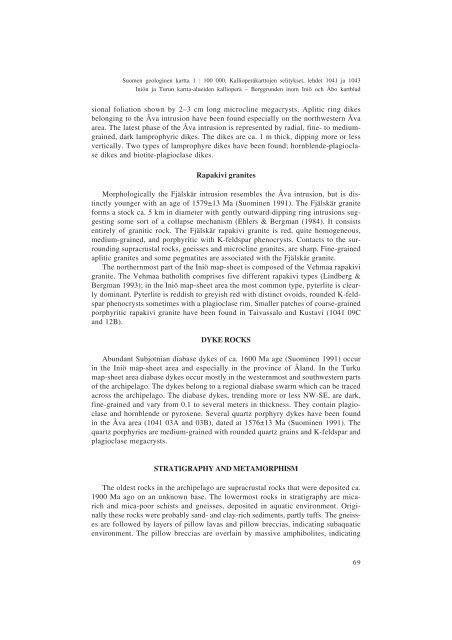Ritva Karhunen - arkisto.gsf.fi - Geologian tutkimuskeskus
Ritva Karhunen - arkisto.gsf.fi - Geologian tutkimuskeskus
Ritva Karhunen - arkisto.gsf.fi - Geologian tutkimuskeskus
Create successful ePaper yourself
Turn your PDF publications into a flip-book with our unique Google optimized e-Paper software.
Suomen geologinen kartta 1 : 100 000, Kallioperäkarttojen selitykset, lehdet 1041 ja 1043<br />
Iniön ja Turun kartta-alueiden kallioperä – Berggrunden inom Iniö och Åbo kartblad<br />
sional foliation shown by 2–3 cm long microcline megacrysts. Aplitic ring dikes<br />
belonging to the Åva intrusion have been found especially on the northwestern Åva<br />
area. The latest phase of the Åva intrusion is represented by radial, <strong>fi</strong>ne- to mediumgrained,<br />
dark lamprophyric dikes. The dikes are ca. 1 m thick, dipping more or less<br />
vertically. Two types of lamprophyre dikes have been found; hornblende-plagioclase<br />
dikes and biotite-plagioclase dikes.<br />
Rapakivi granites<br />
Morphologically the Fjälskär intrusion resembles the Åva intrusion, but is distinctly<br />
younger with an age of 1579±13 Ma (Suominen 1991). The Fjälskär granite<br />
forms a stock ca. 5 km in diameter with gently outward-dipping ring intrusions suggesting<br />
some sort of a collapse mechanism (Ehlers & Bergman (1984). It consists<br />
entirely of granitic rock. The Fjälskär rapakivi granite is red, quite homogeneous,<br />
medium-grained, and porphyritic with K-feldspar phenocrysts. Contacts to the surrounding<br />
supracrustal rocks, gneisses and microcline granites, are sharp. Fine-grained<br />
aplitic granites and some pegmatites are associated with the Fjälskär granite.<br />
The northernmost part of the Iniö map-sheet is composed of the Vehmaa rapakivi<br />
granite. The Vehmaa batholith comprises <strong>fi</strong>ve different rapakivi types (Lindberg &<br />
Bergman 1993); in the Iniö map-sheet area the most common type, pyterlite is clearly<br />
dominant. Pyterlite is reddish to greyish red with distinct ovoids, rounded K-feldspar<br />
phenocrysts sometimes with a plagioclase rim. Smaller patches of coarse-grained<br />
porphyritic rapakivi granite have been found in Taivassalo and Kustavi (1041 09C<br />
and 12B).<br />
DYKE ROCKS<br />
Abundant Subjotnian diabase dykes of ca. 1600 Ma age (Suominen 1991) occur<br />
in the Iniö map-sheet area and especially in the province of Åland. In the Turku<br />
map-sheet area diabase dykes occur mostly in the westernmost and southwestern parts<br />
of the archipelago. The dykes belong to a regional diabase swarm which can be traced<br />
across the archipelago. The diabase dykes, trending more or less NW-SE, are dark,<br />
<strong>fi</strong>ne-grained and vary from 0.1 to several meters in thickness. They contain plagioclase<br />
and hornblende or pyroxene. Several quartz porphyry dykes have been found<br />
in the Åva area (1041 03A and 03B), dated at 1576±13 Ma (Suominen 1991). The<br />
quartz porphyries are medium-grained with rounded quartz grains and K-feldspar and<br />
plagioclase megacrysts.<br />
STRATIGRAPHY AND METAMORPHISM<br />
The oldest rocks in the archipelago are supracrustal rocks that were deposited ca.<br />
1900 Ma ago on an unknown base. The lowermost rocks in stratigraphy are micarich<br />
and mica-poor schists and gneisses, deposited in aquatic environment. Originally<br />
these rocks were probably sand- and clay-rich sediments, partly tuffs. The gneisses<br />
are followed by layers of pillow lavas and pillow breccias, indicating subaquatic<br />
environment. The pillow breccias are overlain by massive amphibolites, indicating<br />
69

















